Inter-Organizational Relationships: A Business Development Report
VerifiedAdded on 2023/04/24
|5
|1244
|150
Report
AI Summary
This report delves into the dynamics of inter-organizational relationships, examining the shift from transactional to collaborative models. It highlights how changes in organizational goals and environment necessitate alterations in these relationships. The report discusses the characteristics of transactional and collaborative relationships, emphasizing the importance of trust, communication, and involvement in fostering stronger bonds. It explores circumstances prompting organizations to modify their relationships, such as shifts in focus and managerial perspectives, using examples like Toyota's lean enterprise model. The report also analyzes how a company's sustainability efforts can influence and be influenced by its network, with examples like Toyota and Tengri UK. Furthermore, it examines the integration of sustainability into supplier and customer relationship management, suggesting strategies like smart marketing and engaging customers through social media to promote sustainable practices. The report concludes by emphasizing the importance of integrating sustainability across organizational networks, supply chains, and consumer communities to achieve broader impact.
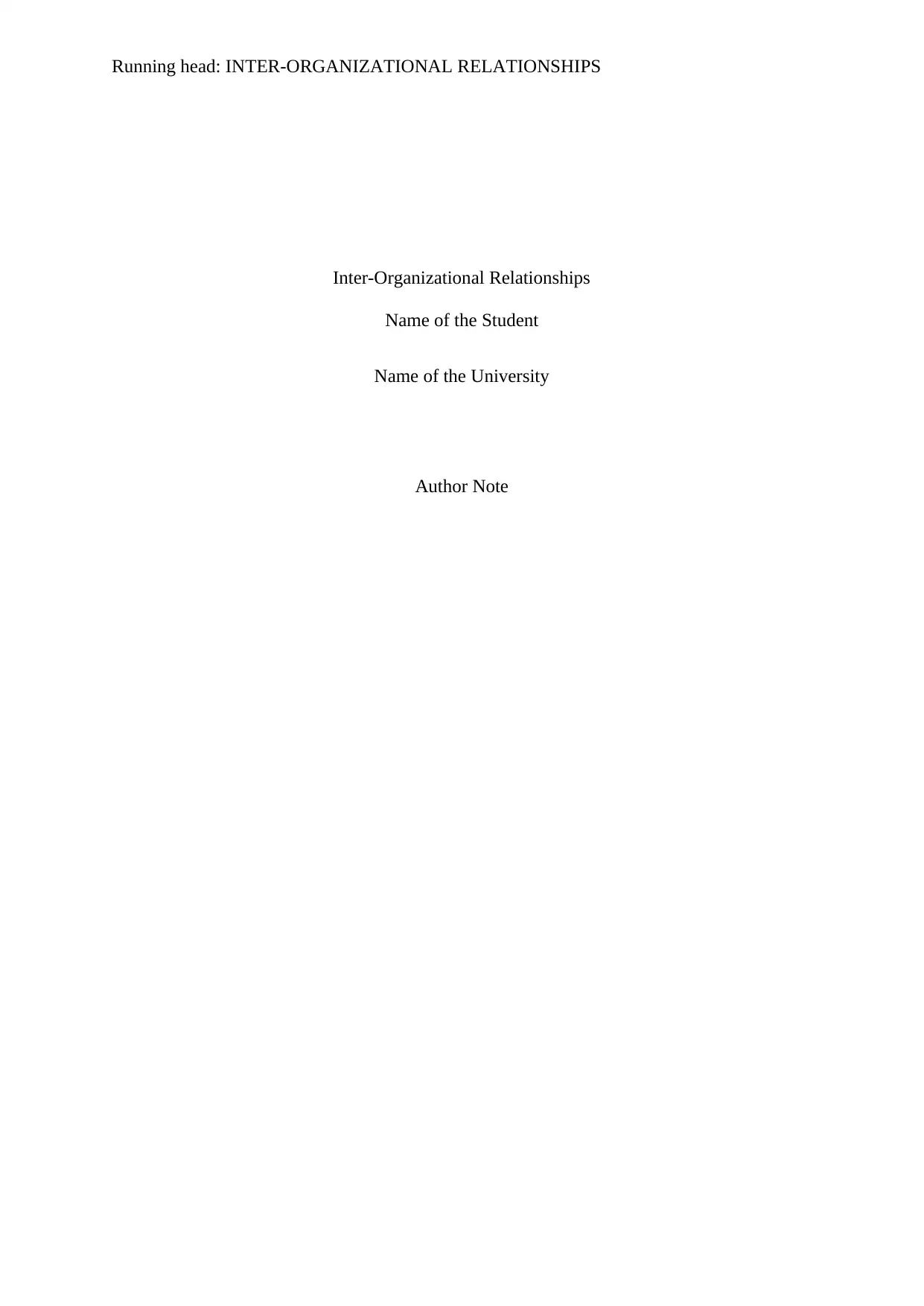
Running head: INTER-ORGANIZATIONAL RELATIONSHIPS
Inter-Organizational Relationships
Name of the Student
Name of the University
Author Note
Inter-Organizational Relationships
Name of the Student
Name of the University
Author Note
Paraphrase This Document
Need a fresh take? Get an instant paraphrase of this document with our AI Paraphraser
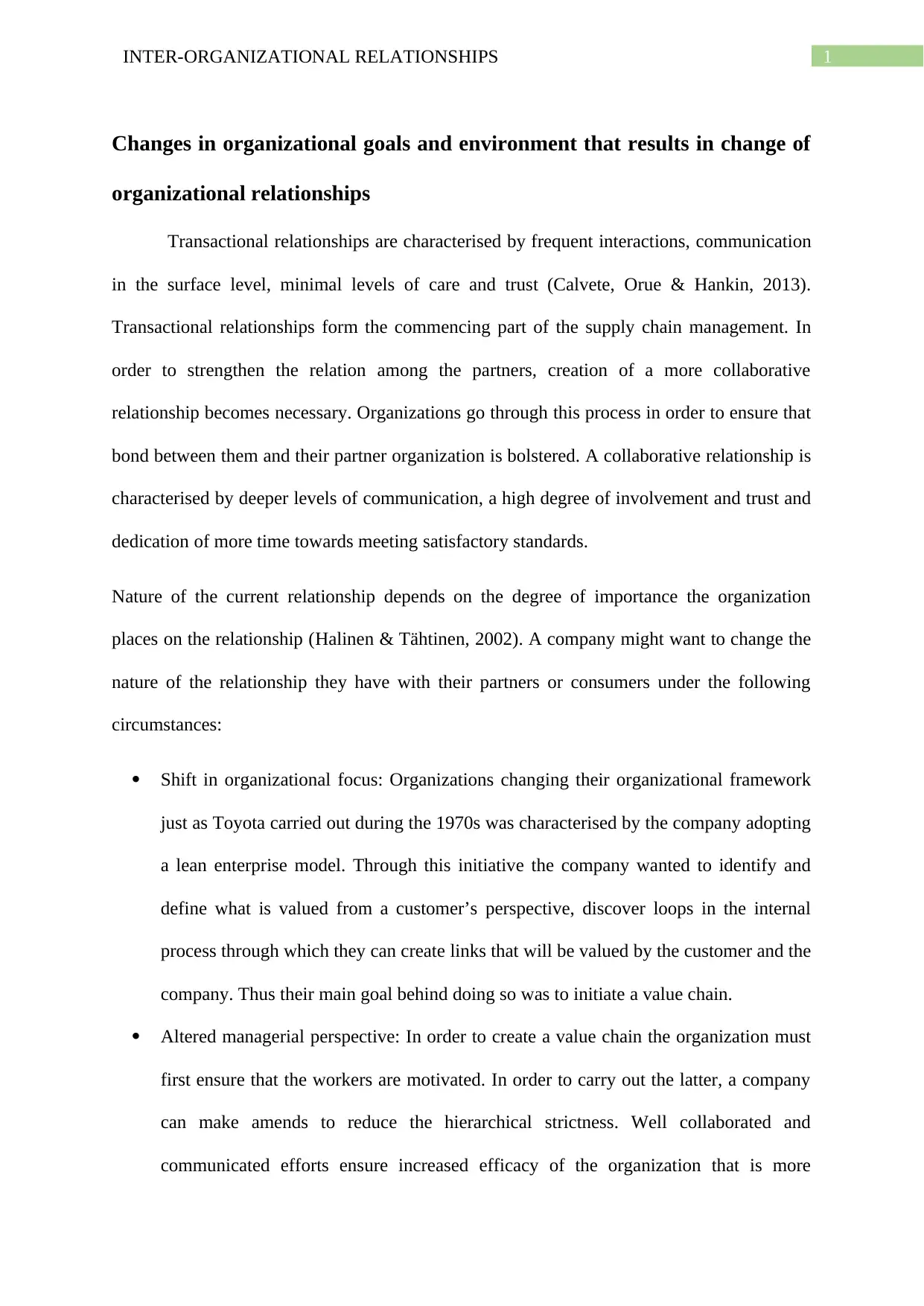
1INTER-ORGANIZATIONAL RELATIONSHIPS
Changes in organizational goals and environment that results in change of
organizational relationships
Transactional relationships are characterised by frequent interactions, communication
in the surface level, minimal levels of care and trust (Calvete, Orue & Hankin, 2013).
Transactional relationships form the commencing part of the supply chain management. In
order to strengthen the relation among the partners, creation of a more collaborative
relationship becomes necessary. Organizations go through this process in order to ensure that
bond between them and their partner organization is bolstered. A collaborative relationship is
characterised by deeper levels of communication, a high degree of involvement and trust and
dedication of more time towards meeting satisfactory standards.
Nature of the current relationship depends on the degree of importance the organization
places on the relationship (Halinen & Tähtinen, 2002). A company might want to change the
nature of the relationship they have with their partners or consumers under the following
circumstances:
Shift in organizational focus: Organizations changing their organizational framework
just as Toyota carried out during the 1970s was characterised by the company adopting
a lean enterprise model. Through this initiative the company wanted to identify and
define what is valued from a customer’s perspective, discover loops in the internal
process through which they can create links that will be valued by the customer and the
company. Thus their main goal behind doing so was to initiate a value chain.
Altered managerial perspective: In order to create a value chain the organization must
first ensure that the workers are motivated. In order to carry out the latter, a company
can make amends to reduce the hierarchical strictness. Well collaborated and
communicated efforts ensure increased efficacy of the organization that is more
Changes in organizational goals and environment that results in change of
organizational relationships
Transactional relationships are characterised by frequent interactions, communication
in the surface level, minimal levels of care and trust (Calvete, Orue & Hankin, 2013).
Transactional relationships form the commencing part of the supply chain management. In
order to strengthen the relation among the partners, creation of a more collaborative
relationship becomes necessary. Organizations go through this process in order to ensure that
bond between them and their partner organization is bolstered. A collaborative relationship is
characterised by deeper levels of communication, a high degree of involvement and trust and
dedication of more time towards meeting satisfactory standards.
Nature of the current relationship depends on the degree of importance the organization
places on the relationship (Halinen & Tähtinen, 2002). A company might want to change the
nature of the relationship they have with their partners or consumers under the following
circumstances:
Shift in organizational focus: Organizations changing their organizational framework
just as Toyota carried out during the 1970s was characterised by the company adopting
a lean enterprise model. Through this initiative the company wanted to identify and
define what is valued from a customer’s perspective, discover loops in the internal
process through which they can create links that will be valued by the customer and the
company. Thus their main goal behind doing so was to initiate a value chain.
Altered managerial perspective: In order to create a value chain the organization must
first ensure that the workers are motivated. In order to carry out the latter, a company
can make amends to reduce the hierarchical strictness. Well collaborated and
communicated efforts ensure increased efficacy of the organization that is more
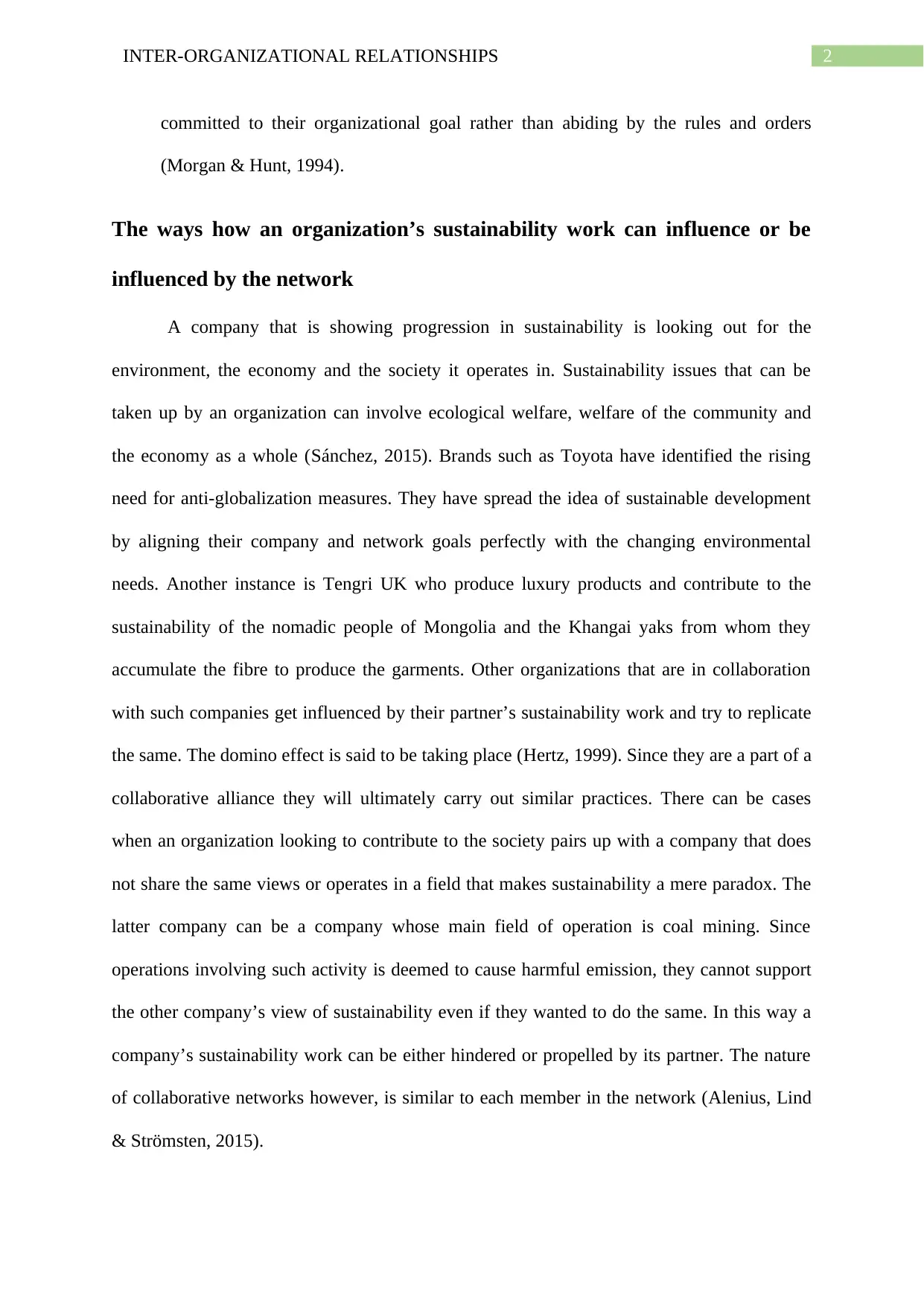
2INTER-ORGANIZATIONAL RELATIONSHIPS
committed to their organizational goal rather than abiding by the rules and orders
(Morgan & Hunt, 1994).
The ways how an organization’s sustainability work can influence or be
influenced by the network
A company that is showing progression in sustainability is looking out for the
environment, the economy and the society it operates in. Sustainability issues that can be
taken up by an organization can involve ecological welfare, welfare of the community and
the economy as a whole (Sánchez, 2015). Brands such as Toyota have identified the rising
need for anti-globalization measures. They have spread the idea of sustainable development
by aligning their company and network goals perfectly with the changing environmental
needs. Another instance is Tengri UK who produce luxury products and contribute to the
sustainability of the nomadic people of Mongolia and the Khangai yaks from whom they
accumulate the fibre to produce the garments. Other organizations that are in collaboration
with such companies get influenced by their partner’s sustainability work and try to replicate
the same. The domino effect is said to be taking place (Hertz, 1999). Since they are a part of a
collaborative alliance they will ultimately carry out similar practices. There can be cases
when an organization looking to contribute to the society pairs up with a company that does
not share the same views or operates in a field that makes sustainability a mere paradox. The
latter company can be a company whose main field of operation is coal mining. Since
operations involving such activity is deemed to cause harmful emission, they cannot support
the other company’s view of sustainability even if they wanted to do the same. In this way a
company’s sustainability work can be either hindered or propelled by its partner. The nature
of collaborative networks however, is similar to each member in the network (Alenius, Lind
& Strömsten, 2015).
committed to their organizational goal rather than abiding by the rules and orders
(Morgan & Hunt, 1994).
The ways how an organization’s sustainability work can influence or be
influenced by the network
A company that is showing progression in sustainability is looking out for the
environment, the economy and the society it operates in. Sustainability issues that can be
taken up by an organization can involve ecological welfare, welfare of the community and
the economy as a whole (Sánchez, 2015). Brands such as Toyota have identified the rising
need for anti-globalization measures. They have spread the idea of sustainable development
by aligning their company and network goals perfectly with the changing environmental
needs. Another instance is Tengri UK who produce luxury products and contribute to the
sustainability of the nomadic people of Mongolia and the Khangai yaks from whom they
accumulate the fibre to produce the garments. Other organizations that are in collaboration
with such companies get influenced by their partner’s sustainability work and try to replicate
the same. The domino effect is said to be taking place (Hertz, 1999). Since they are a part of a
collaborative alliance they will ultimately carry out similar practices. There can be cases
when an organization looking to contribute to the society pairs up with a company that does
not share the same views or operates in a field that makes sustainability a mere paradox. The
latter company can be a company whose main field of operation is coal mining. Since
operations involving such activity is deemed to cause harmful emission, they cannot support
the other company’s view of sustainability even if they wanted to do the same. In this way a
company’s sustainability work can be either hindered or propelled by its partner. The nature
of collaborative networks however, is similar to each member in the network (Alenius, Lind
& Strömsten, 2015).
⊘ This is a preview!⊘
Do you want full access?
Subscribe today to unlock all pages.

Trusted by 1+ million students worldwide
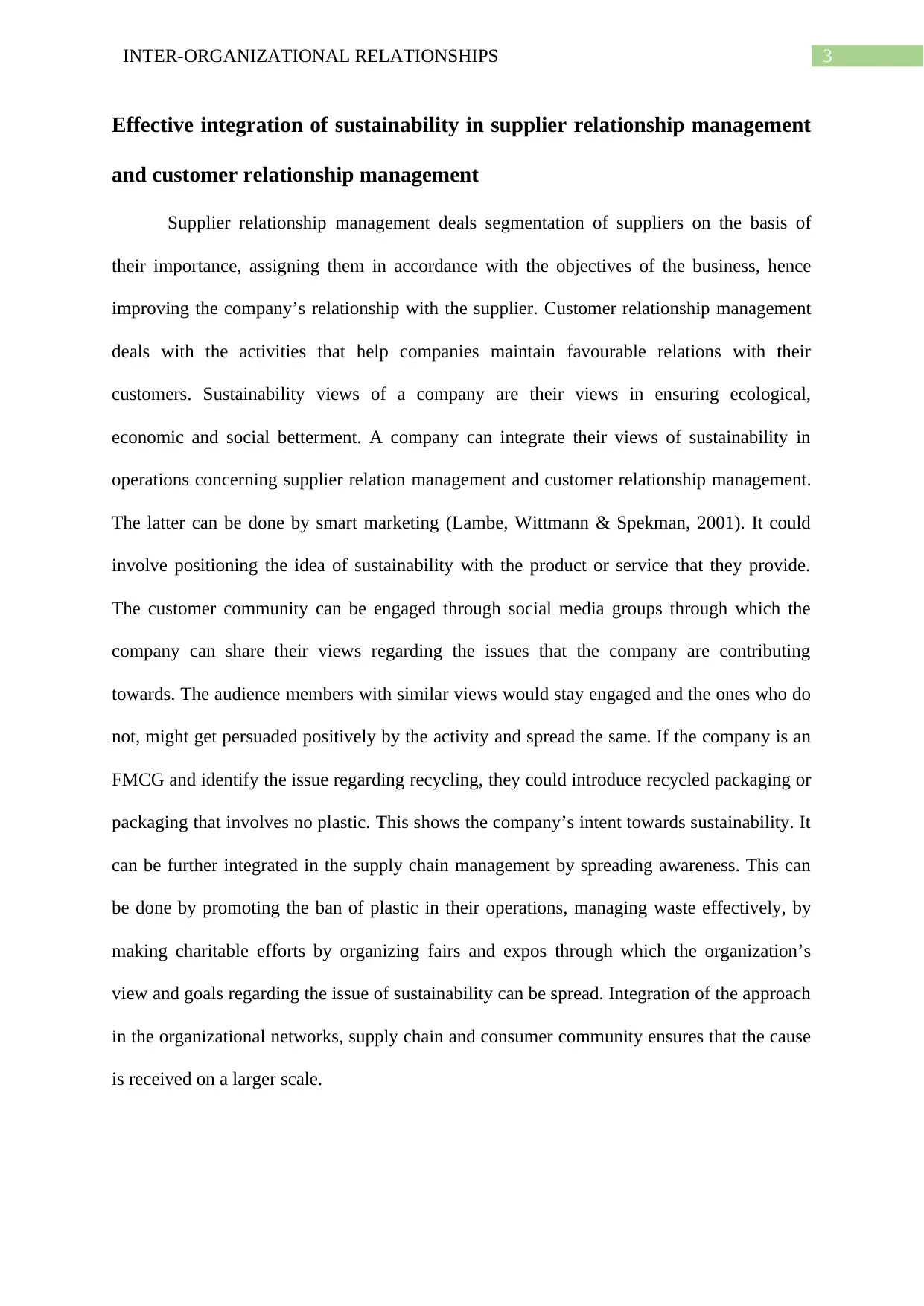
3INTER-ORGANIZATIONAL RELATIONSHIPS
Effective integration of sustainability in supplier relationship management
and customer relationship management
Supplier relationship management deals segmentation of suppliers on the basis of
their importance, assigning them in accordance with the objectives of the business, hence
improving the company’s relationship with the supplier. Customer relationship management
deals with the activities that help companies maintain favourable relations with their
customers. Sustainability views of a company are their views in ensuring ecological,
economic and social betterment. A company can integrate their views of sustainability in
operations concerning supplier relation management and customer relationship management.
The latter can be done by smart marketing (Lambe, Wittmann & Spekman, 2001). It could
involve positioning the idea of sustainability with the product or service that they provide.
The customer community can be engaged through social media groups through which the
company can share their views regarding the issues that the company are contributing
towards. The audience members with similar views would stay engaged and the ones who do
not, might get persuaded positively by the activity and spread the same. If the company is an
FMCG and identify the issue regarding recycling, they could introduce recycled packaging or
packaging that involves no plastic. This shows the company’s intent towards sustainability. It
can be further integrated in the supply chain management by spreading awareness. This can
be done by promoting the ban of plastic in their operations, managing waste effectively, by
making charitable efforts by organizing fairs and expos through which the organization’s
view and goals regarding the issue of sustainability can be spread. Integration of the approach
in the organizational networks, supply chain and consumer community ensures that the cause
is received on a larger scale.
Effective integration of sustainability in supplier relationship management
and customer relationship management
Supplier relationship management deals segmentation of suppliers on the basis of
their importance, assigning them in accordance with the objectives of the business, hence
improving the company’s relationship with the supplier. Customer relationship management
deals with the activities that help companies maintain favourable relations with their
customers. Sustainability views of a company are their views in ensuring ecological,
economic and social betterment. A company can integrate their views of sustainability in
operations concerning supplier relation management and customer relationship management.
The latter can be done by smart marketing (Lambe, Wittmann & Spekman, 2001). It could
involve positioning the idea of sustainability with the product or service that they provide.
The customer community can be engaged through social media groups through which the
company can share their views regarding the issues that the company are contributing
towards. The audience members with similar views would stay engaged and the ones who do
not, might get persuaded positively by the activity and spread the same. If the company is an
FMCG and identify the issue regarding recycling, they could introduce recycled packaging or
packaging that involves no plastic. This shows the company’s intent towards sustainability. It
can be further integrated in the supply chain management by spreading awareness. This can
be done by promoting the ban of plastic in their operations, managing waste effectively, by
making charitable efforts by organizing fairs and expos through which the organization’s
view and goals regarding the issue of sustainability can be spread. Integration of the approach
in the organizational networks, supply chain and consumer community ensures that the cause
is received on a larger scale.
Paraphrase This Document
Need a fresh take? Get an instant paraphrase of this document with our AI Paraphraser
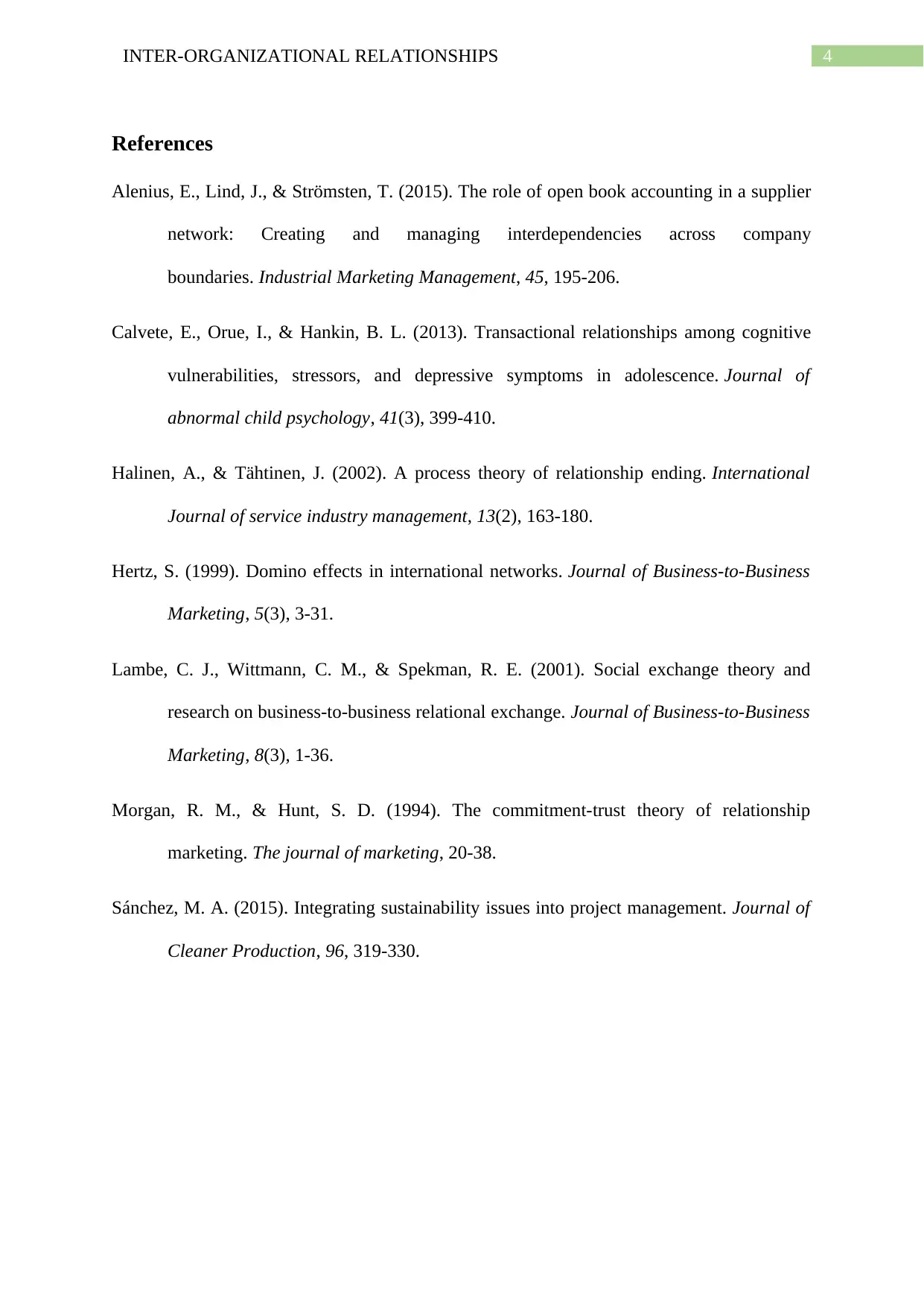
4INTER-ORGANIZATIONAL RELATIONSHIPS
References
Alenius, E., Lind, J., & Strömsten, T. (2015). The role of open book accounting in a supplier
network: Creating and managing interdependencies across company
boundaries. Industrial Marketing Management, 45, 195-206.
Calvete, E., Orue, I., & Hankin, B. L. (2013). Transactional relationships among cognitive
vulnerabilities, stressors, and depressive symptoms in adolescence. Journal of
abnormal child psychology, 41(3), 399-410.
Halinen, A., & Tähtinen, J. (2002). A process theory of relationship ending. International
Journal of service industry management, 13(2), 163-180.
Hertz, S. (1999). Domino effects in international networks. Journal of Business-to-Business
Marketing, 5(3), 3-31.
Lambe, C. J., Wittmann, C. M., & Spekman, R. E. (2001). Social exchange theory and
research on business-to-business relational exchange. Journal of Business-to-Business
Marketing, 8(3), 1-36.
Morgan, R. M., & Hunt, S. D. (1994). The commitment-trust theory of relationship
marketing. The journal of marketing, 20-38.
Sánchez, M. A. (2015). Integrating sustainability issues into project management. Journal of
Cleaner Production, 96, 319-330.
References
Alenius, E., Lind, J., & Strömsten, T. (2015). The role of open book accounting in a supplier
network: Creating and managing interdependencies across company
boundaries. Industrial Marketing Management, 45, 195-206.
Calvete, E., Orue, I., & Hankin, B. L. (2013). Transactional relationships among cognitive
vulnerabilities, stressors, and depressive symptoms in adolescence. Journal of
abnormal child psychology, 41(3), 399-410.
Halinen, A., & Tähtinen, J. (2002). A process theory of relationship ending. International
Journal of service industry management, 13(2), 163-180.
Hertz, S. (1999). Domino effects in international networks. Journal of Business-to-Business
Marketing, 5(3), 3-31.
Lambe, C. J., Wittmann, C. M., & Spekman, R. E. (2001). Social exchange theory and
research on business-to-business relational exchange. Journal of Business-to-Business
Marketing, 8(3), 1-36.
Morgan, R. M., & Hunt, S. D. (1994). The commitment-trust theory of relationship
marketing. The journal of marketing, 20-38.
Sánchez, M. A. (2015). Integrating sustainability issues into project management. Journal of
Cleaner Production, 96, 319-330.
1 out of 5
Related Documents
Your All-in-One AI-Powered Toolkit for Academic Success.
+13062052269
info@desklib.com
Available 24*7 on WhatsApp / Email
![[object Object]](/_next/static/media/star-bottom.7253800d.svg)
Unlock your academic potential
Copyright © 2020–2025 A2Z Services. All Rights Reserved. Developed and managed by ZUCOL.




